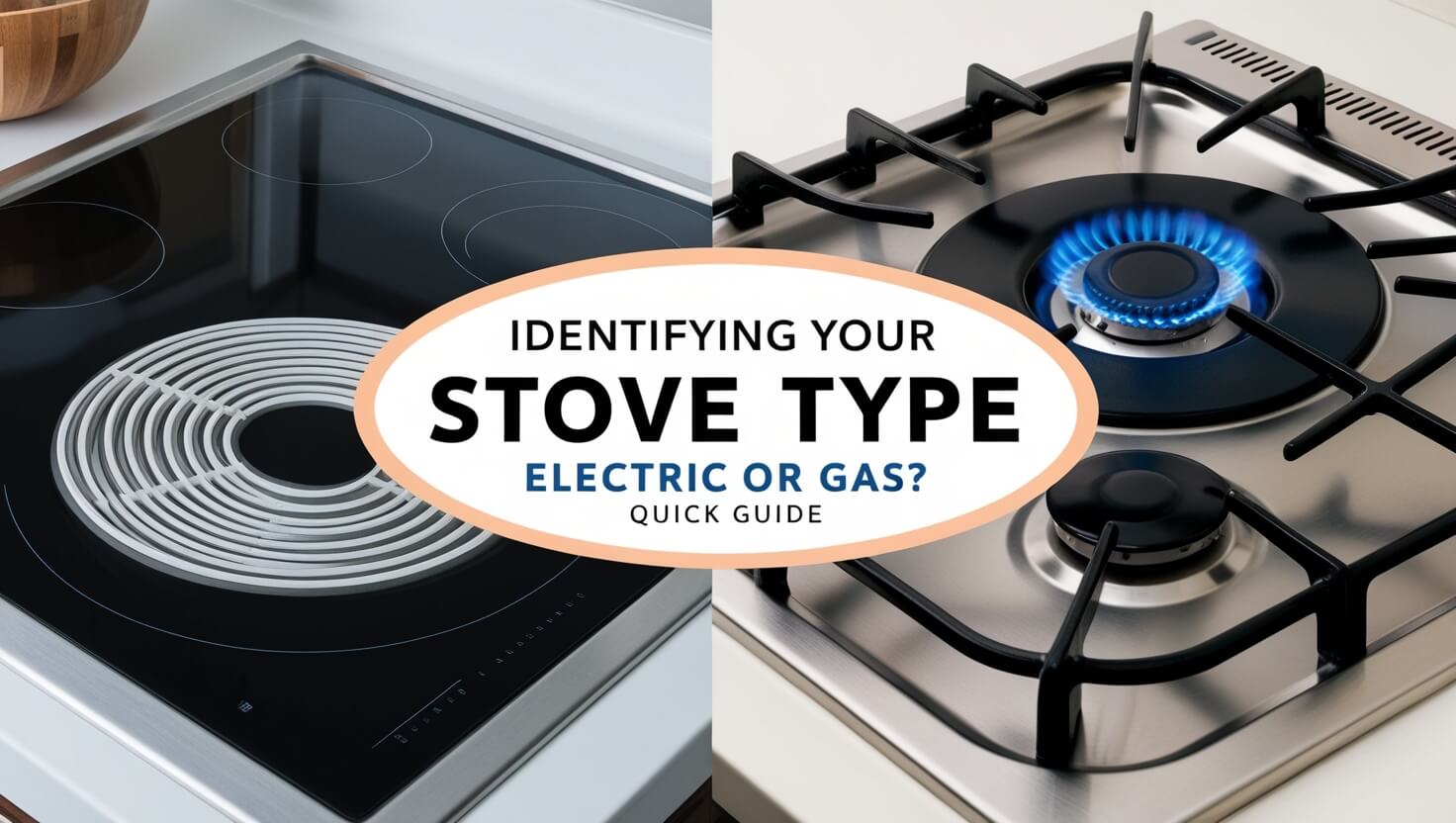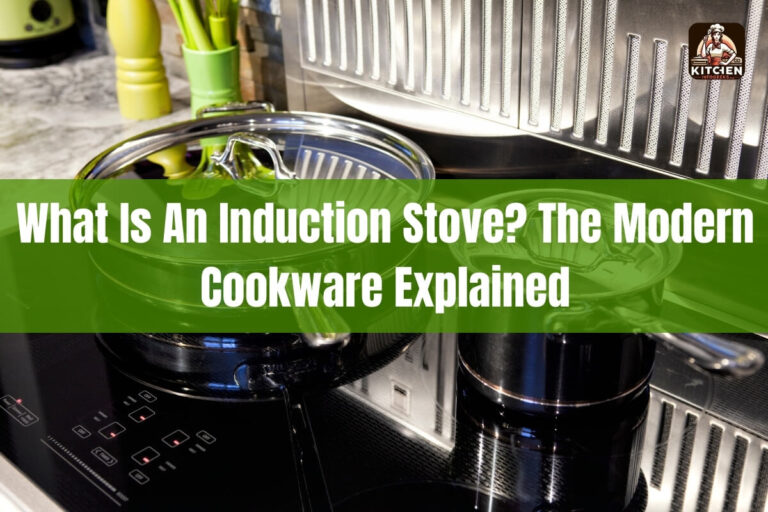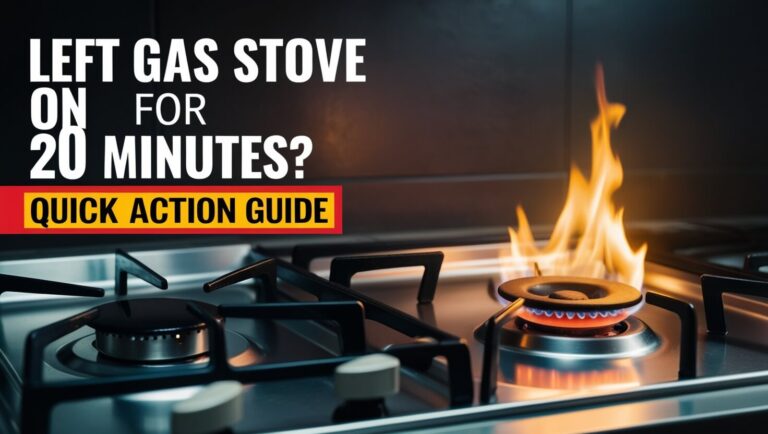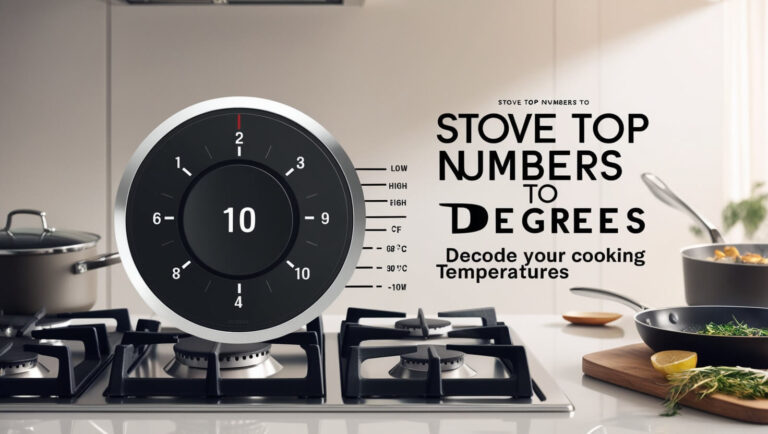
Your stove is electric if it has a smooth glass top or visible coils, and it’s gas if you see open flames and metal grates. This guide will help you identify your stove type, understand its features, and make informed decisions about cooking and energy use.
Visual Clues to Identify Your Stove Type
Figuring out whether you have an electric or gas stove isn’t as tricky as it might seem. Let’s look at some easy-to-spot differences.
Examining the Cooktop Surface
Electric stoves often have a flat, smooth surface. It’s usually made of glass or ceramic. You might see circular outlines where the heating elements are. Gas stoves, on the other hand, have metal grates covering the burners.
Looking for Burners and Heating Elements
On a gas stove, you’ll see actual burners under the grates. They’re typically round with small holes where the gas comes out. Electric stoves have either visible coils or hidden elements under a flat surface.
Checking for Gas Connections
If you’re still unsure, look behind or under the stove. Gas stoves need a gas line connection. It’s usually a flexible metal hose. Electric stoves just have a power cord.
Operational Differences Between Electric and Gas Stoves
Now that you can spot the difference, let’s talk about how they work.
Ignition and Startup Process
Turn on a gas stove, and you’ll hear a clicking sound. That’s the ignition trying to light the gas. You’ll see a blue flame when it’s lit. Electric stoves are quieter. The burner just starts to glow red as it heats up.
Heat Control and Responsiveness
Gas stoves react quickly when you change the temperature. Turn the knob, and the flame gets bigger or smaller right away. Electric stoves take a bit longer to heat up or cool down.
Cooling Down Time
After cooking, gas burners cool off fast. You can usually touch the grates pretty soon after turning off the flame. Electric stoves, especially flat-top ones, stay hot for a while. Be careful!
Energy Source and Power Requirements
Your stove’s energy needs can tell you a lot about its type.
Gas Line vs. Electrical Outlet
Gas stoves need a natural gas or propane supply. If your home doesn’t have gas lines, you probably have an electric stove. Electric stoves plug into a wall outlet, but not just any outlet.
Voltage Needs for Electric Stoves
Electric stoves use a lot of power. They need a special 240-volt outlet. It’s bigger than regular outlets and often has its own circuit breaker.
Performance Characteristics
Let’s talk about how these stoves perform in the kitchen.
Cooking Speed and Efficiency
Gas stoves heat up pans quickly. The flame wraps around the bottom of the pot, heating it evenly. Electric stoves can be a bit slower, but newer models are catching up.
Temperature Precision and Control
Many cooks prefer gas for its precise control. You can see the flame and adjust it easily. Electric stoves have numbered dials, which can be less intuitive but still effective.
Heat Distribution in the Oven
Electric ovens often heat more evenly. They’re great for baking. Gas ovens can have hot spots, but some cooks like this for certain dishes.
Maintenance and Cleaning Considerations
Keeping your stove clean is important. Here’s how it differs between types.
Cleaning Electric Stovetops
Smooth-top electric stoves are easy to wipe clean. For coil types, you might need to lift the coils to clean underneath. Use special cleaners for glass tops to avoid scratches.
Maintaining Gas Burners and Grates
Gas stoves need a bit more work. You’ll have to remove the grates and clean around the burners. Make sure the gas holes don’t get clogged with food debris.
Safety Features and Concerns
Both types of stoves have safety issues to consider.
Electric Stove Safety
Electric stoves don’t have open flames, which some people prefer. But remember, the cooktop can stay hot long after you’ve finished cooking.
Gas Stove Safety Precautions
With gas stoves, you need to be aware of gas leaks. Make sure you have a carbon monoxide detector in your kitchen. Also, be careful of loose clothing near the open flames.
Cost and Energy Efficiency Comparison
Let’s talk money. Which type of stove is easier on your wallet?
Initial Purchase and Installation Costs
Electric stoves are often cheaper to buy. Gas stoves might cost more upfront, especially if you need to install a gas line.
Long-term Operating Expenses
In many areas, natural gas is cheaper than electricity. This means gas stoves can be cheaper to run over time. But it really depends on energy prices where you live.
Environmental Impact of Electric vs. Gas Stoves
Your stove choice can affect more than just your cooking.
Carbon Footprint Considerations
The environmental impact of your stove depends on where your energy comes from. If your electricity is from renewable sources, an electric stove might be greener. Gas stoves always burn fossil fuels.
Indoor Air Quality Effects
Gas stoves can affect your indoor air quality. They release some pollutants when burning. Electric stoves don’t have this issue, which is something to think about if you have respiratory concerns.
Cooking Preferences and Culinary Applications
Different stoves suit different cooking styles.
Professional Chef Preferences
Many pro chefs prefer gas stoves. They like the quick response and the ability to char foods directly over the flame. But some top chefs are switching to induction, a type of electric cooking.
Best Stove Type for Various Cooking Techniques
For high-heat stir-frying, gas stoves work great. Electric stoves, especially smoothtop ones, are good for simmering and keeping a steady low heat.
Troubleshooting Common Issues
Every stove can have problems. Here’s what to look out for.
Electric Stove Problems
If your electric stove isn’t heating, check if it’s plugged in properly. Sometimes a burner or heating element might need replacing.
Gas Stove Troubleshooting
If you smell gas, turn off the stove and open windows right away. For ignition problems, the igniter might be dirty or need replacing.
Making the Switch: Converting from One Type to Another
Thinking of changing your stove type? Here’s what you need to know.
Electric to Gas Conversion
To switch to gas, you’ll need a gas line installed if you don’t already have one. This can be expensive and might require permits.
Gas to Electric Transition
Going from gas to electric is usually easier. You’ll need to cap off the gas line and install a 240-volt outlet if you don’t have one.
Future Trends in Stove Technology
Stove technology is always improving. Let’s look at what’s coming.
Advancements in Electric and Induction Cooking
Induction cooking is becoming more popular. It’s fast, efficient, and safe. Some new electric stoves have smart features like Wi-Fi connectivity.
Innovations in Gas Stove Design
New gas stoves are more efficient than ever. Some have dual fuel options, combining a gas cooktop with an electric oven for the best of both worlds.
Knowing whether your stove is electric or gas helps you cook better and safer. It also lets you make smart choices about energy use and kitchen upgrades. Whether you’re a seasoned chef or a cooking newbie, understanding your stove is the first step to great meals.






